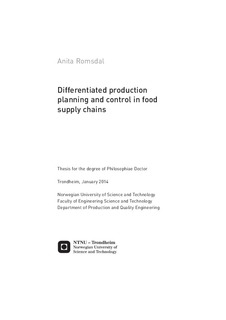| dc.contributor.author | Romsdal, Anita | nb_NO |
| dc.date.accessioned | 2014-12-19T12:21:16Z | |
| dc.date.available | 2014-12-19T12:21:16Z | |
| dc.date.created | 2014-02-04 | nb_NO |
| dc.date.issued | 2014 | nb_NO |
| dc.identifier | 693453 | nb_NO |
| dc.identifier.isbn | 978-82-471-4943-0 (printed ver.) | nb_NO |
| dc.identifier.isbn | 978-82-471-4944-7 (electronic ver.) | nb_NO |
| dc.identifier.uri | http://hdl.handle.net/11250/240963 | |
| dc.description.abstract | The PhD thesis reports on an empirical and exploratory investigation of the strategic determination of the principles used to guide production planning and control (PPC) in the food sector. Food producers have traditionally focused on offering customers high quality products at low prices, and products are generally made to stock (MTS) to meet customers' delivery lead time expectations. Efficiency in food production is critical and producers have relied on producing in large volumes to keep unit costs down. On the other hand, customers also require producers to respond quickly to changes in the market place.
In an attempt to better meet customer requirements, the food sector has adopted more market-oriented principles in the way production is planned and controlled - shifting from the dominant MTS approach to applying more make-to-order (MTO) and combined MTO-MTS approaches. However, which PPC approach to choose in which situation is still unclear. This study therefore investigated how food producers can differentiate their PPC approaches to better meet the requirements for both responsiveness and efficiency. Four research questions (RQs) guided the research:
RQ1: What are the characteristics of food supply chains?RQ2: How can PPC be differentiated according to food supply chain characteristics?RQ3: What are the potential benefits of differentiated PPC?RQ4: What are the tactical and operational challenges of differentiated PPC?
The RQs were addressed using a design science approach combining literature studies and a case study. The case study was conducted in TINE, Norway's largest producer, distributor and exporter of dairy products. The study was mainly conducted in the period 2010-2013, and analyses were performed and solutions developed in close collaboration with company representatives in order to strengthen the trustworthiness of findings and results.
RQ1 found that the market and product characteristics typically require responsiveness from food producers, while producers' production systems are mainly focused on efficiency through exploitation of scale benefits. Thus, there is a lack of strategic fit between the external requirements stemming from product and market characteristics and the capabilities of the production system to enable the required level of responsiveness and efficiency.
In order to answer RQ2, a concept for differentiated PPC was developed, consisting of the following principles:
Favourable product and market characteristics like low perishability, high demand predictability and long customer order lead time allowances should be exploited to provide flexibility to the production systemPPC approaches should be differentiated according to food supply chain configurations, i.e. product and market combinationsSlack resources in the form of inventory, capacity and time should be differentiated to buffer against demand uncertainty
Based on these principles, a framework for differentiated PPC was developed. The framework identifies appropriate PPC approaches and buffering techniques for each supply chain configuration. The concept and framework were then used to design a new PPC system for the case facility, also leading to the development of a decision tree for determining a product's demand predictability.
RQ3 investigated the potential benefits of the differentiation approach to PPC. The proposed PPC system was not implemented as part of the study and effects could therefore not be measured. Expected benefits were instead substantiated by combining insights from literature and the case study, with effects grouped into six categories; improved quality, higher speed, better dependability, higher flexibility, reduced costs, and improved performance of the PPC function.
The concept for differentiated PPC is based on combining MTO and MTS in the same production system, and RQ4 discussed the additional challenges this imposes on the tactical and operational PPC levels. The discussion concluded that the traditional material requirements planning (MRP) method is likely to continue to be the backbone of PPC in the food sector, but that MRP combined with a workload control (WLC) planning method could be a potential solution for tactical and operational PPC in such hybrid production environments. | nb_NO |
| dc.language | eng | nb_NO |
| dc.publisher | Norges teknisk-naturvitenskapelige universitet, Fakultet for ingeniørvitenskap og teknologi, Institutt for produksjons- og kvalitetsteknikk | nb_NO |
| dc.relation.ispartofseries | Doktoravhandlinger ved NTNU, 1503-8181; 2014:16 | nb_NO |
| dc.title | Differentiated production planning and control in food supply chains | nb_NO |
| dc.type | Doctoral thesis | nb_NO |
| dc.contributor.department | Norges teknisk-naturvitenskapelige universitet, Fakultet for ingeniørvitenskap og teknologi, Institutt for produksjons- og kvalitetsteknikk | nb_NO |
| dc.description.degree | PhD i produksjons- og kvalitetsteknikk | nb_NO |
| dc.description.degree | PhD in Production and Quality Engineering | en_GB |
